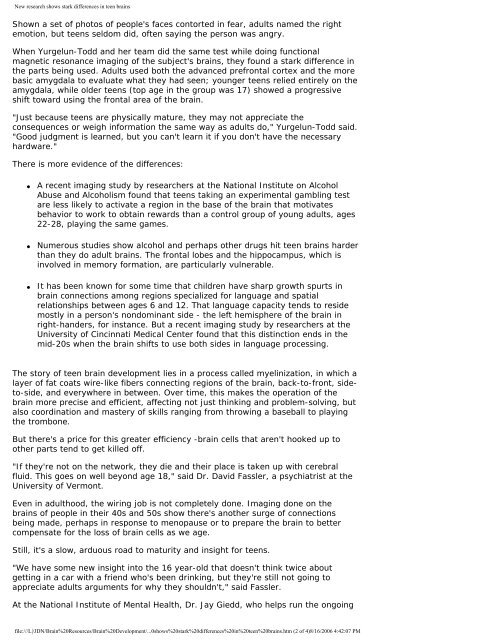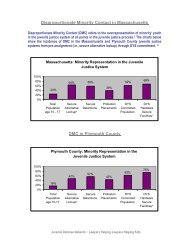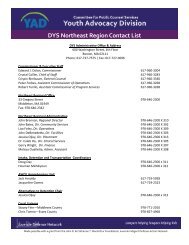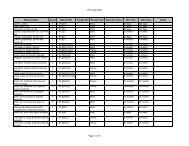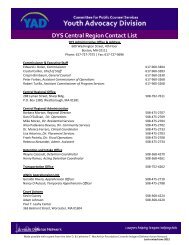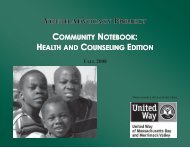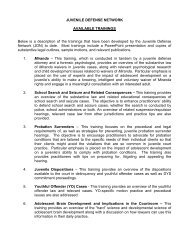States rethink 'adult time for adult crime' - the Youth Advocacy Division
States rethink 'adult time for adult crime' - the Youth Advocacy Division
States rethink 'adult time for adult crime' - the Youth Advocacy Division
Create successful ePaper yourself
Turn your PDF publications into a flip-book with our unique Google optimized e-Paper software.
New research shows stark differences in teen brains<br />
Shown a set of photos of people's faces contorted in fear, <strong>adult</strong>s named <strong>the</strong> right<br />
emotion, but teens seldom did, often saying <strong>the</strong> person was angry.<br />
When Yurgelun-Todd and her team did <strong>the</strong> same test while doing functional<br />
magnetic resonance imaging of <strong>the</strong> subject's brains, <strong>the</strong>y found a stark difference in<br />
<strong>the</strong> parts being used. Adults used both <strong>the</strong> advanced prefrontal cortex and <strong>the</strong> more<br />
basic amygdala to evaluate what <strong>the</strong>y had seen; younger teens relied entirely on <strong>the</strong><br />
amygdala, while older teens (top age in <strong>the</strong> group was 17) showed a progressive<br />
shift toward using <strong>the</strong> frontal area of <strong>the</strong> brain.<br />
"Just because teens are physically mature, <strong>the</strong>y may not appreciate <strong>the</strong><br />
consequences or weigh in<strong>for</strong>mation <strong>the</strong> same way as <strong>adult</strong>s do," Yurgelun-Todd said.<br />
"Good judgment is learned, but you can't learn it if you don't have <strong>the</strong> necessary<br />
hardware."<br />
There is more evidence of <strong>the</strong> differences:<br />
●<br />
A recent imaging study by researchers at <strong>the</strong> National Institute on Alcohol<br />
Abuse and Alcoholism found that teens taking an experimental gambling test<br />
are less likely to activate a region in <strong>the</strong> base of <strong>the</strong> brain that motivates<br />
behavior to work to obtain rewards than a control group of young <strong>adult</strong>s, ages<br />
22-28, playing <strong>the</strong> same games.<br />
●<br />
Numerous studies show alcohol and perhaps o<strong>the</strong>r drugs hit teen brains harder<br />
than <strong>the</strong>y do <strong>adult</strong> brains. The frontal lobes and <strong>the</strong> hippocampus, which is<br />
involved in memory <strong>for</strong>mation, are particularly vulnerable.<br />
●<br />
It has been known <strong>for</strong> some <strong>time</strong> that children have sharp growth spurts in<br />
brain connections among regions specialized <strong>for</strong> language and spatial<br />
relationships between ages 6 and 12. That language capacity tends to reside<br />
mostly in a person's nondominant side - <strong>the</strong> left hemisphere of <strong>the</strong> brain in<br />
right-handers, <strong>for</strong> instance. But a recent imaging study by researchers at <strong>the</strong><br />
University of Cincinnati Medical Center found that this distinction ends in <strong>the</strong><br />
mid-20s when <strong>the</strong> brain shifts to use both sides in language processing.<br />
The story of teen brain development lies in a process called myelinization, in which a<br />
layer of fat coats wire-like fibers connecting regions of <strong>the</strong> brain, back-to-front, sideto-side,<br />
and everywhere in between. Over <strong>time</strong>, this makes <strong>the</strong> operation of <strong>the</strong><br />
brain more precise and efficient, affecting not just thinking and problem-solving, but<br />
also coordination and mastery of skills ranging from throwing a baseball to playing<br />
<strong>the</strong> trombone.<br />
But <strong>the</strong>re's a price <strong>for</strong> this greater efficiency -brain cells that aren't hooked up to<br />
o<strong>the</strong>r parts tend to get killed off.<br />
"If <strong>the</strong>y're not on <strong>the</strong> network, <strong>the</strong>y die and <strong>the</strong>ir place is taken up with cerebral<br />
fluid. This goes on well beyond age 18," said Dr. David Fassler, a psychiatrist at <strong>the</strong><br />
University of Vermont.<br />
Even in <strong>adult</strong>hood, <strong>the</strong> wiring job is not completely done. Imaging done on <strong>the</strong><br />
brains of people in <strong>the</strong>ir 40s and 50s show <strong>the</strong>re's ano<strong>the</strong>r surge of connections<br />
being made, perhaps in response to menopause or to prepare <strong>the</strong> brain to better<br />
compensate <strong>for</strong> <strong>the</strong> loss of brain cells as we age.<br />
Still, it's a slow, arduous road to maturity and insight <strong>for</strong> teens.<br />
"We have some new insight into <strong>the</strong> 16 year-old that doesn't think twice about<br />
getting in a car with a friend who's been drinking, but <strong>the</strong>y're still not going to<br />
appreciate <strong>adult</strong>s arguments <strong>for</strong> why <strong>the</strong>y shouldn't," said Fassler.<br />
At <strong>the</strong> National Institute of Mental Health, Dr. Jay Giedd, who helps run <strong>the</strong> ongoing<br />
file:///L|/JDN/Brain%20Resources/Brain%20Development/...0shows%20stark%20differences%20in%20teen%20brains.htm (2 of 4)8/16/2006 4:42:07 PM


